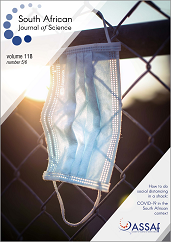The intersection of age, sex, race and socio-economic status in COVID-19 hospital admissions and deaths in South Africa (with corrigendum)
DOI:
https://doi.org/10.17159/sajs.2022/13323Keywords:
COVID-19, hospitalisation, mortality, race, age, sex, socio-economic statusAbstract
Older age, male sex, and non-white race have been reported to be risk factors for COVID-19 mortality. Few studies have explored how these intersecting factors contribute to COVID-19 outcomes. This study aimed to compare demographic characteristics and trends in SARS-CoV-2 admissions and the health care they received. Hospital admission data were collected through DATCOV, an active national COVID-19 surveillance programme. Descriptive analysis was used to compare admissions and deaths by age, sex, race, and health sector as a proxy for socio-economic status. COVID-19 mortality and healthcare utilisation were compared by race using random effect multivariable logistic regression models. On multivariable analysis, black African patients (adjusted OR [aOR] 1.3, 95% confidence interval [CI] 1.2, 1.3), coloured patients (aOR 1.2, 95% CI 1.1, 1.3), and patients of Indian descent (aOR 1.2, 95% CI 1.2, 1.3) had increased risk of in-hospital COVID-19 mortality compared to white patients; and admission in the public health sector (aOR 1.5, 95% CI 1.5, 1.6) was associated with increased risk of mortality compared to those in the private sector. There were higher percentages of COVID-19 hospitalised individuals treated in ICU, ventilated, and treated with supplemental oxygen in the private compared to the public sector. There were increased odds of non-white patients being treated in ICU or ventilated in the private sector, but decreased odds of black African patients being treated in ICU (aOR 0.5; 95% CI 0.4, 0.5) or ventilated (aOR 0.5; 95% CI 0.4, 0.6) compared to white patients in the public sector. These findings demonstrate the importance of collecting and analysing data on race and socio-economic status to ensure that disease control measures address the most vulnerable populations affected by COVID-19.
Significance:
- These findings demonstrate the importance of collecting data on socio-economic status and race alongside age and sex, to identify the populations most vulnerable to COVID-19.
- This study allows a better understanding of the pre-existing inequalities that predispose some groups to poor disease outcomes and yet more limited access to health interventions.
- Interventions adapted for the most vulnerable populations are likely to be more effective.
- The national government must provide efficient and inclusive non-discriminatory health services, and urgently improve access to ICU, ventilation and oxygen in the public sector.
- Transformation of the healthcare system is long overdue, including narrowing the gap in resources between the private and public sectors.
Downloads
Additional Files
Published
Issue
Section
License

All articles are published under a Creative Commons Attribution 4.0 International Licence
Copyright is retained by the authors. Readers are welcome to reproduce, share and adapt the content without permission provided the source is attributed.
Disclaimer: The publisher and editors accept no responsibility for statements made by the authors
How to Cite
- Abstract 2160
- PDF 1287
- EPUB 544
- XML 547
- Supplementary material 139
- Corrigendum 58













.png)